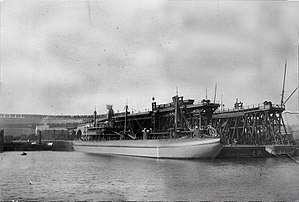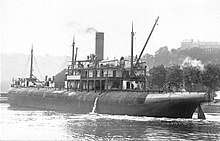SS Sagamore
SS Sagamore was the only British-built whaleback freighter. She was built in 1893, in Sunderland, England by the William Doxford & Sons shipyard;[1] she was built under license from Scottish-American Captain Alexander McDougall (1845–1923).[2]
 The Sagamore in tied up at a Sunderland dock | |
| History | |
|---|---|
| Name: | |
| Operator: |
|
| Builder: | William Doxford & Sons |
| Yard number: | 218 |
| Launched: | 15 June 1893 |
| Completed: | September 1893 |
| In service: | 1893 |
| Out of service: | 1917 |
| Fate: | torpedoed off Spain on 4 May 1917 |
| General characteristics | |
| Tonnage: | 2,140 tons |
| Length: | 308 ft (94 m) |
| Beam: | 38 ft (12 m) |
| Height: | 24 ft (7.3 m) |
History
Construction
Whalebacks had a rather unique design. They had an unusual cylindrical, cigar shaped hull that when fully loaded resembled the back of the whale, hence the name.[3] Their hulls were built of heavy steel plates double-riveted to steel angle frames. They were the predecessors of the Doxford turret deck ships of the late 19th and early 20th century, just like whalebacks they had a rounded hull, but unlike whalebacks they had a conventional bow, stern and superstructure. A total of 44 whaleback vessels were constructed from 1888 to 1898, with most of them (except for two) operating in the Great Lakes.[upper-alpha 1][3]
Service

The Sagamore was refused entry to England because of her unusual design.[2] She was owned by the Belgian American Maritime Co (which was restyled the Belgian Maritime Trading Co SA). In 1896 she was sold again to Cogneti Schiaffino of Genoa, Italy and renamed Solideo in 1911.[1] She was renamed again as Ilva in 1916[1] and finally purchased by A Piaggio of Genoa in 1916. She was sailing between Genoa and Barry Roads when she was torpedoed and sunk in the Atlantic off the coast of Spain on 4 May 1917 by UC-69. There were no casualties.[2][6]
References
Notes
- Charles W. Wetmore was the first whaleback to leave the lakes in June, 1891, sailing to London and from there to the west coast of the United States, where it grounded and became a total loss.[4] The City of Everett was an significant whaleback steamer. She was constructed in the State of Washington, sailed from her construction in 1894 until her sinking in 1923, and was the first U.S. steamship to pass through the Suez Canal as well as the first to circumnavigate the globe.[5]
Citations
- "SS Ilva (+1917)". Wrecksite. Retrieved 26 March 2018.
- "The Sunderland Site Page 052". www.searlecanada.org.
- Woodman 2002, p. 179.
- "Today in Great Lakes History June 30". Great Lakes & Seaway Shipping News Archive. Boatnerd. Archived from the original on 5 August 2007. Retrieved 8 February 2008.
- "Last of the Whalebacks". Sea Classics. 2004.
- "Ilva". Uboat.net. Retrieved 26 March 2018.
Bibliography
- Woodman, Richard (2002) [1997]. The History of the Ship. London: Lyons Press (Globe Pequot Press)/Conway Maritime Press. p. 179. ISBN 1-58574-621-5.CS1 maint: ref=harv (link)
External links
- History of Doxford engines
- Miramar Ship Index - Sagamore
- Helgason, Guðmundur. "Ships hit during WWI: Ilva". German and Austrian U-boats of World War I - Kaiserliche Marine - Uboat.net.
- Lloyd's Register of British and Foreign Shipping (1902) Lloyd's Register of British and Foreign Shipping